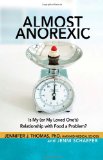Co-written with guest author Jennifer J. Thomas, Ph.D., Assistant Professor of Psychology, Harvard Medical School
"I'm concerned about my daughter. She doesn't have anorexia... but she almost does."
I hear this all the time. So does clinical psychologist Jennifer J. Thomas, coauthor of my latest book Almost Anorexic, which is the fourth in Harvard Medical School's The Almost Effect series.
While only 1 in 200 American adults will develop anorexia nervosa in their lifetime, at least 1 in 20 (1 in 10 teen girls!) will struggle with restricting, bingeing and/or purging that doesn't meet full diagnostic criteria for anorexia nervosa, bulimia nervosa or binge eating disorder. Because the vast majority of individuals who battle food and body image problems can relate to an anorexic mindset that values extreme thinness and relentless control over eating, we call this once overlooked category almost anorexic.
When I was lost in my eating disorder, I waited many years in the purgatory of almost anorexia before finally getting help, which I did only when my symptoms finally met obvious diagnostic criteria. In college, I distinctly remember two students giving a talk about eating disorders in a health communications class. I sat attentively at my desk, intrigued by the definitions of anorexia and bulimia, but not connecting the dots at all that I might have an eating disorder myself. I must not have a problem, I thought.
But I did. I sometimes wonder if I might have sought help sooner had this particular presentation included even just a mention of the fact that most eating disorders don't fit neatly into diagnostic boxes.
Some hold the dangerous misconception that the pain and suffering that accompanies almost anorexia is somehow less severe than that associated with anorexia nervosa. This explains why on planes or at parties, Dr. Thomas and I are often asked, "How can I become almost anorexic?", as if engaging in eating disorder symptoms at an average or above-average body weight is benign or even desirable.
But almost anorexia isn't just dieting to fit into your prom dress or running a 5K race with your friends. Subthreshold eating disorders can be just as severe as anorexia nervosa in the areas of eating pathology, physical complications and other mental health problems (e.g. anxiety, depression) according to research by Dr. Thomas, who is also Co-Director of the Eating Disorders Clinical and Research Program at Massachusetts General Hospital. Similarly, the mortality rate of subthreshold eating disorders is similar to that of anorexia and bulimia nervosa.
The medical community actually has a term for these subthreshold syndromes, but it's a bit complex. I had never heard of it when I was struggling. It's called Other Specific Feeding or Eating Disorder (OSFED) according to the Diagnostic and Statistical Manual of Mental Disorders, 5th edition (DSM-5). A previous version used the term Eating Disorder Not Otherwise Specified (EDNOS; in DSM-IV). It is important to note that OSFED and EDNOS are, in fact, eating disorders. Again, these terms just denote forms of the illness that don't meet the narrow criteria for anorexia, bulimia and binge eating disorder. Unfortunately, few people outside the mental health field are familiar with these specialized terms, and it can feel confusing and even invalidating to be diagnosed with an acronym.
According to McCall Dempsey, whose symptoms fell in the dangerous gray area between normal eating and anorexia nervosa, "I was officially diagnosed with EDNOS, which, at the time, only further amplified the voice in my mind that said, 'See you're not that bad. You're not sick enough.'"
But support is available regardless of the number on the scale or the unique profile of eating-disordered symptoms. We encourage people who struggle not to let a metal contraption on the bathroom floor or some words in a medical book interfere with getting help. New research suggests that many of the same techniques that are useful for the treatment of anorexia nervosa and bulimia nervosa (e.g., family-based treatment, cognitive-behavioral therapy, and others) can provide relief for those with almost anorexia.
If you think you or a loved one might be struggling, you can take a free and confidential screening at www.almostanorexic.com. Research shows that the sooner people receive treatment, the more likely they are to recover. Data also suggest (and my personal experience shows!) that full recovery is possible.
Look for Jenni Schaefer and Jennifer J. Thomas, Ph.D. on the Today show this morning!
This video shares the stories of individuals whose lives have been touched by almost anorexia.
For resources in your area, visit www.MyNEDA.org. You can also evaluate your relationship with physical activity by taking the Compulsive Exercise Test.
<!--
Books by this author
-->
Follow Jenni Schaefer on Twitter:
www.twitter.com/JenniSchaefer



